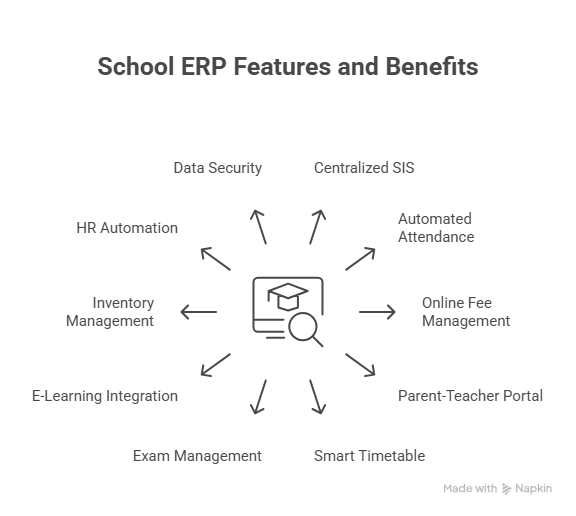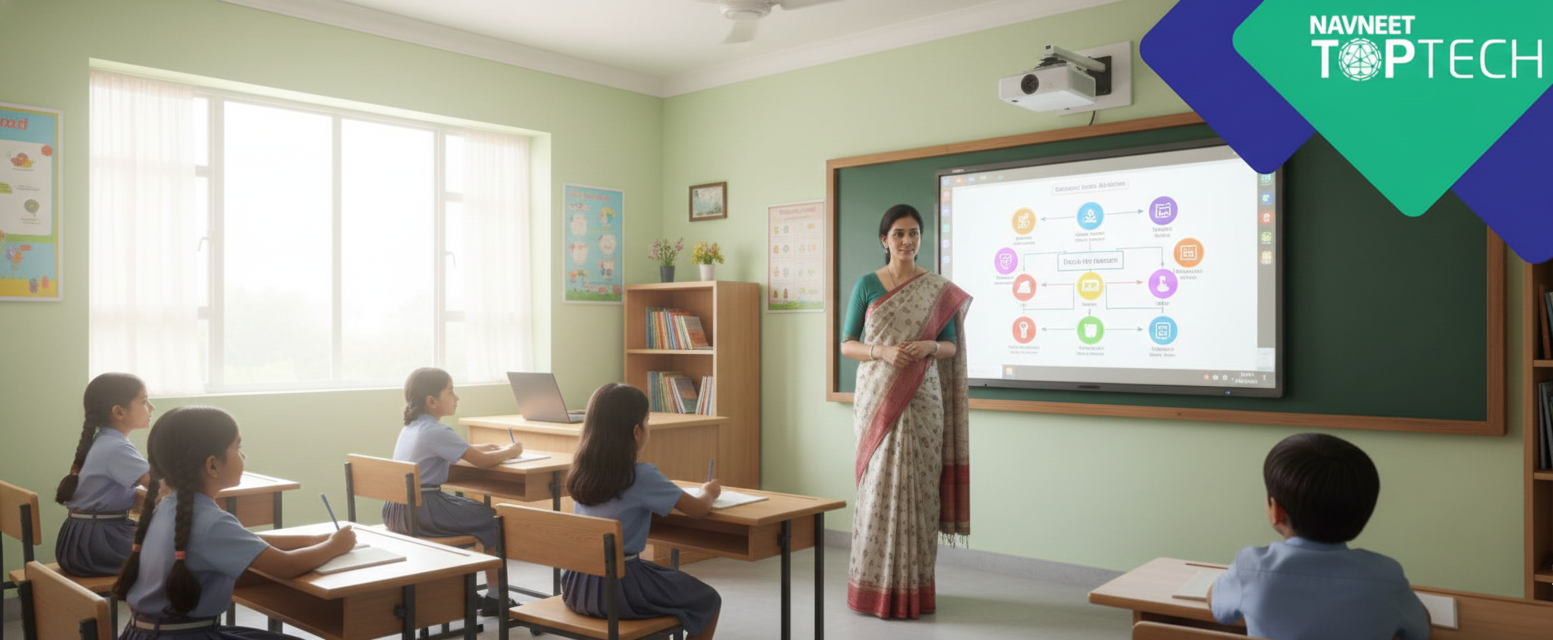Managing a school in 2025 is a complex operation. The modern education ecosystem demands real-time communication, seamless data flow, and automated processes that work together without friction. This is where School ERP software steps in, transforming how schools operate, connect, and grow. It’s a system that connects siloed functions, automates routine tasks, and gives decision-makers real-time visibility into operations.
With technology evolving fast, the real question today is: Which features truly matter? In this blog, we break down the top features of school ERP software in 2025 that represent the gold standard that every school should consider non-negotiable.
What is School ERP Software?
A School ERP (Enterprise Resource Planning) system is a comprehensive digital platform that brings every academic and administrative process under one roof. Instead of juggling separate tools for attendance, fee collection, scheduling, and communication, schools can manage them through an integrated interface.
The strength of a modern school ERP lies in its ability to connect staff, teachers, parents, and students in real time. From reducing paperwork to improving transparency, it’s designed to make schools more efficient and adaptable.
For a deeper understanding of its components and benefits, explore our detailed guide: What is ERP for Schools
In 2025, however, not every ERP system delivers the same value. The difference lies in the features and their applicability to your needs that determine how well the system supports both your day-to-day operations and long-term growth. Below, we break down the top 10 features of school ERP software in 2025 that every institution should look for.
Core Features Every School ERP Should Have in 2025

- Centralized Student Information System (SIS)
The foundation of any School ERP is a centralized student database that houses academic records, personal details, attendance history, performance data, and more, all in one place. This eliminates scattered files and ensures instant access for authorized staff. In 2025, advanced SIS platforms will also integrate analytics, making it easier to track trends like attendance dips or subject-specific performance issues.
Derived Benefits: Reduces administrative errors, saves time, and supports better decision-making.
- Automated Attendance Management
Manual roll calls and attendance registers are prone to delays and inaccuracies. Automated systems powered by check-ins, biometrics, or RFID make attendance tracking seamless for both students and staff Automated Attendance Management
Manual roll calls and attendance registers are prone to delays and inaccuracies. Automated systems powered by check-ins, biometrics, or RFID make attendance tracking seamless for both students and staff through modern school attendance management software. In 2025, some systems will even send instant notifications to parents when a student is marked absent.
Derived Benefits: Frees up teaching time, improves accuracy, and strengthens communication with parents.. In 2025, some systems will even send instant notifications to parents when a student is marked absent.
Derived Benefits: Frees up teaching time, improves accuracy, and strengthens communication with parents.
- Online Fee Management System
Fee collection can be one of the most resource-heavy processes in a school. A cloud-based fee management module allows parents to pay securely online, track dues, and download receipts instantly. For administrators, it simplifies reconciliation and reporting. Integration with accounting systems further reduces manual work.
Derived Benefits: Improves transparency, ensures timely payments, and saves countless hours in financial processing.
- Parent-Teacher Communication Portal
Strong school-parent relationships build on consistent and transparent communication. A dedicated portal or mobile app inside the ERP allows for quick sharing of academic updates, event schedules, report cards, and urgent notifications, without waiting for the next parent-teacher meeting.
Derived Benefits: Enhances trust, reduces information gaps, and engages parents in the learning process.
- Smart Timetable & Scheduling
Building timetables manually is a time-consuming puzzle. AI-assisted scheduling tools within ERP systems now factor in teacher availability, subject requirements, and room capacity to automatically generate conflict-free timetables. They also make last-minute adjustments effortlessly, ensuring smoother operations and balanced workloads.
Derived Benefits: Eliminates scheduling errors, optimizes resource allocation, and adapts quickly to changes.
- Examination & Report Card Management
From question paper generation to automated grading and online report card publishing, an ERP’s exam management module can handle the full cycle. Teachers can enter marks directly, generate report cards with custom formats, and deliver them to parents securely online.
Schools can even integrate this with learning analytics to track progress over time, giving teachers data-driven insights into student performance.
Derived Benefits: Reduces human error, speeds up result processing, and supports personalized learning strategies.
- E-Learning & LMS Integration
With blended learning becoming the norm, integration between School ERP and Learning Management Systems (LMS) is essential. This feature allows teachers to upload lessons, share assignments, and conduct assessments within the same system, ensuring learning continues seamlessly both in and out of the classroom. The students also get uninterrupted access to class materials, recorded lectures, and quizzes directly through the ERP platform or mobile app.
Derived Benefits: Creates a unified learning experience, improves accessibility, and supports remote or hybrid learning models.
- Inventory & Library Management
Keeping track of books, lab equipment, uniforms, and other school resources is no small task. ERP-based inventory modules offer real-time tracking, automated issue-return systems, and low-stock alerts. The library module can manage catalogues, reservations, and overdue fines digitally. Administrators can see stock levels, loan histories, and replenishment needs, preventing shortages and minimizing losses.
Derived Benefits: Saves costs, minimizes losses, and ensures resources are used efficiently.
- HR & Payroll Automation
Managing staff data, leave records, salaries, and compliance manually is a drain on time and accuracy. An ERP with HR and payroll automation centralizes employee records, processes payroll, calculates deductions, and ensures statutory compliance with minimal intervention.
Derived Benefits: Reduces payroll errors, ensures timely payments, and improves staff satisfaction.
- Data Security & Role-Based Access
With sensitive academic and financial data moving online, security cannot be an afterthought. A cloud-based school ERP software in 2025 must offer encrypted data storage, regular backups, and role-based permissions to control who can access what. This not only safeguards information but also ensures compliance with data protection laws.
Derived Benefits: Protects sensitive school data and maintains trust among stakeholders.
How to Choose the Right School ERP Software
Choosing an ERP isn’t about finding the system with the best features; it’s about finding the right fit for your school’s size, structure, and goals.
Here’s what to consider:
- Match features to needs: Start by identifying your school’s main challenges, whether that’s improving communication, streamlining finances, or enhancing data security and select an ERP that addresses them directly.
- Scalability: Ensure the system can grow with your institution, from adding more users to integrating new modules.
- Ease of use: Look for intuitive dashboards and mobile app access to encourage adoption by all stakeholders. Prioritize cloud-based school ERP software with mobile access for flexibility.
- Vendor support: Check if your provider offers onboarding help, updates, and responsive service to ensure smooth adoption. Evaluate after-sales service, training options, and tech support.
Ready to Upgrade Your School ERP?
In 2025, the difference between a school that runs efficiently and one that struggles often comes down to the quality of its ERP system. The top features of school ERP software today go beyond basic digitization; they enable smarter decision-making, strengthen communication, and create a more connected learning environment. The right platform doesn’t just store data, it moves people, processes, and decisions forward in sync.
This is exactly where NAVNEET TOPTECH makes a difference. Its ERP platform is built with the very features outlined above, from centralized student information and automated fee management to LMS integration, HR automation, and role-based security, so schools don’t have to compromise on what matters. By bringing these essentials together in a single, cloud-based system, NAVNEET TOPTECH empowers schools to operate with efficiency today while staying future-ready for tomorrow.
NAVNEET TOPTECH is built to help schools work smarter, respond faster, and achieve more. It’s not just about keeping up with the times, but about setting the pace. The tools are ready. The technology is here. The next move belongs to your school.




